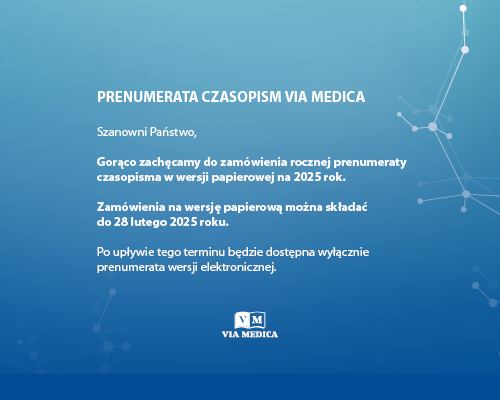Zastosowanie kliniczne świeżo mrożonego osocza w szpitalu referencyjnym w Indiach
Streszczenie
Wstęp. W ciągu ostatniej dekady znacznie zwiększyło się zużycie świeżo mrożonego osocza
(fresh frozen plasma, FFP), co spowodowało rosnącą tendencję do nieuzasadnionego stosowania
FFP, a tym samym narażenie pacjentów na ryzyko związane z zakażeniami i niezakaźnymi
powikłaniami. Badanie przeprowadzono w celu zaobserwowania, w jaki sposób stosuje się
FFP w referencyjnym szpitalu w Indiach.
Materiał i metody. Przeanalizowano w sposób prospektywny wszystkie przypadki zamówień
osocza. Stosowano jednorodne formularze zamówienia i odnotowano dane demograficzne
chorych, wskazania do transfuzji, dawkę, parametry krzepliwości krwi przed transfuzją oraz
zdarzenia niepożądane. Prawidłowe stosowanie definiowano jako zgodność z krajowymi i międzynarodowymi
standardami. Do analizy danych użyto oprogramowania SPSS, wersja 20
(IBM, Stany Zjednoczone).
Wyniki. Ogółem 998 chorym (66% mężczyzn) podano 4991 jednostek osocza, a średnia liczba
transfuzji na pacjenta wynosiła 2. Większość stanowiły osoby dorosłe (83.6%; n = 835).
Największą grupę stanowili pacjenci internistyczni (32%) i osoby poddające się zabiegom z zakresu
chirurgii plastycznej (17%). Najczęstszym wskazaniem było krwawienie z koagulopatią
obserwowane u 41% (411/998) chorych. Średnia objętość podanego osocza wynosiła 456,2
± 287,4 (17 do 2800) ml na transfuzję. Wartość INR przed transfuzją była dostępna tylko
w 63,2% (n = 1317) epizodów. Ogółem, 56% (n = 1169) epizodów uznano za prawidłowe.
W 0,28% przypadków zaobserwowano działania niepożądane i zgłoszono je do krajowej bazy
nadzoru hematologicznego. Odnotowano 72 przypadki zgonów (7,2% chorych).
Wnioski. Stosowana praktyka dotycząca transfuzji osocza była umiarkowanie zgodna ze standardami.
Najczęściej stwierdzanymi nieprawidłowościami było stosowanie FFP w przypadku
niedoborów białkowych i w ramach profilaktyki przy braku jakichkolwiek oznak krwawienia.
Słowa kluczowe: świeżo mrożone osoczeprawidłowe stosowaniezastosowanie klinicznewytyczne





